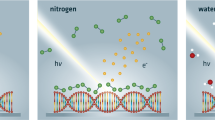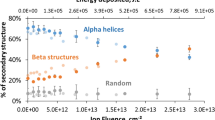Abstract
THE immediate effect of the absorption of highenergy radiation (α-, β-, γ- and X-rays, fast protons, deuterons, etc.) by water is the ejection of electrons from the water molecules lying along the tracks of the rays. There has been much discussion concerning the mechanism of the chemical changes which occur in water or dilute aqueous solution as a result of this ‘primary radiochemical act’. Many of the investigations1 have been concerned primarily with measurement of the ion pair yield (M/N is number of product molecules formed or reactant molecules decomposed per ion pair), and for such purposes it was sufficient to regard the radiation as producing ‘activated water’2, an unspecified intermediate capable of bringing about the observed changes and formed in amounts proportional to the dose. Recent reconsideration of the types of chemical reactions undergone by the solutes has led to the view, proposed by Weiss and now widely held3, that the activated water consists of a hydrogen atom and hydroxyl radical, formed possibly by direct dissociation of water, or by electron capture and ion breakdown processes such as
This is a preview of subscription content, access via your institution
Access options
Subscribe to this journal
Receive 51 print issues and online access
$199.00 per year
only $3.90 per issue
Buy this article
- Purchase on Springer Link
- Instant access to full article PDF
Prices may be subject to local taxes which are calculated during checkout
Similar content being viewed by others
References
For a review of these effects, see Allsopp, Trans. Farad. Soc., 40, 79 (1944).
Ref. 1, p. 84.
See, for example, Weiss, Nature, 153, 748 (1944); Lea, "Actions of Radiations on Living Cells" (Cambridge, 1946); Burton, M., address to spring meeting of the American Chemical Society at Atlanta City (1946), to be published.
Baxendale, Evans and Park, Trans. Farad. Soc., 42, 155 (1946).
Dainton, to be published.
See, for example, Melville, Proc. Roy. Soc., A, 163, 511 (1937).
Baxendale, Evans and Kilham, Trans. Farad. Soc., 42, 668 (1946). Baxendale, Bywater and Evans, ibid., p. 675.
Bacon, Trans. Farad. Soc., 42, 145 (1946); also ref. 4, p. 163–65.
Author information
Authors and Affiliations
Rights and permissions
About this article
Cite this article
DAINTON, F. Effect of Gamma- and X-Rays on Dilute Aqueous Solutions of Acrylonitrile. Nature 160, 268–269 (1947). https://doi.org/10.1038/160268a0
Issue Date:
DOI: https://doi.org/10.1038/160268a0
This article is cited by
-
Radical polymerization of methyl methacrylate (MMA) initiated by KHSO5 – BTBAC system - a kinetic study
Journal of Polymer Research (2012)
-
Detection of Free Hydroxyl Radicals by Hydroxylation of Aromatic Compounds
Nature (1950)
-
Chemical Effects of Ionizing Radiations
Nature (1948)
Comments
By submitting a comment you agree to abide by our Terms and Community Guidelines. If you find something abusive or that does not comply with our terms or guidelines please flag it as inappropriate.



